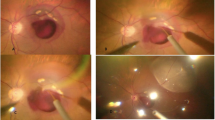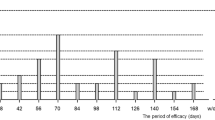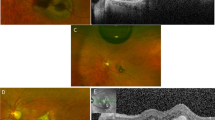Abstract
Purpose
To describe the efficacy of intravitreal aflibercept on 12-month visual and anatomical outcomes in patients with neovascular age-related macular degeneration (AMD) recalcitrant to prior monthly intravitreal bevacizumab or ranibizumab.
Methods
Non-comparative case series of 21 eyes of 21 AMD patients with evidence of persistent exudation (intraretinal fluid/cysts, or subretinal fluid (SRF), or both) on spectral domain OCT despite ≥6 prior intravitreal 0.5 mg ranibizumab or 1.25 mg bevacizumab (mean 29.8±17.1 injections) over 31.6±17.4 months who were transitioned to aflibercept.
Results
At baseline, best-corrected visual acuity (BCVA) was 0.42±0.28 logarithm of minimum-angle of resolution (logMAR), central foveal thickness (CFT) was 329.38±102.67 μm and macular volume (MV) was 7.71±1.32 mm3. After 12 months of aflibercept (mean 10.2±1.2 injections), BCVA was 0.40±0.28 logMAR (P=0.5), CFT decreased to 292.71±91.35 μm (P=0.038) and MV improved to 7.33±1.27 mm3 (P=0.003). In a subset of 15 eyes with a persistent fibrovascular or serous pigment epithelial detachment (PED), mean baseline PED greatest basal diameter (GBD) was 2350.9±1067.6 μm and mean maximal height (MH) was 288.7±175.9 μm. At 12 months, GBD improved to 1896.3±782.3 μm (P=0.028), while MH decreased to 248.27±146.2 μm (P=0.002).
Conclusion
In patients with recalcitrant AMD, aflibercept led to anatomic improvement at 12 months, reduction in proportion of eyes with SRF and reduction in PED, while preserving visual acuity.
Similar content being viewed by others
Log in or create a free account to read this content
Gain free access to this article, as well as selected content from this journal and more on nature.com
or
References
Group CR, Martin DF, Maguire MG, Ying GS, Grunwald JE, Fine SL et al. Ranibizumab and bevacizumab for neovascular age-related macular degeneration. N Engl J Med 2011; 364: 1897–1908.
Stewart MW, Rosenfeld PJ, Penha FM, Wang F, Yehoshua Z, Bueno-Lopez E et al. Pharmacokinetic rationale for dosing every 2 weeks versus 4 weeks with intravitreal ranibizumab, bevacizumab, and aflibercept (vascular endothelial growth factor Trap-eye). Retina 2012; 32: 434–457.
Ho VY, Yeh S, Olsen TW, Bergstrom CS, Yan J, Cribbs BE et al. Short-term outcomes of aflibercept for neovascular age-related macular degeneration in eyes previously treated with other vascular endothelial growth factor inhibitors. Am J Ophthalmol 2013; 156 (1): 23–28.e2.
Bakall B, Folk JC, Boldt HC, Sohn EH, Stone EM, Russell SR et al. Aflibercept therapy for exudative age-related macular degeneration resistant to bevacizumab and ranibizumab. Am J Ophthalmol 2013; 156: 15–22. e11.
Yonekawa Y, Andreoli C, Miller JB, Loewenstein JT, Sobrin L, Eliott D et al. Conversion to aflibercept for chronic refractory or recurrent neovascular age-related macular degeneration. Am J Ophthalmol 2013; 156 (1): 29–35.e2.
Cho H, Shah CP, Weber M, Heier JS . Aflibercept for exudative AMD with persistent fluid on ranibizumab and/or bevacizumab. Br J Ophthalmol 2013; 97: 1032–1035.
Patel KH, Chow CC, Rathod R, Mieler WF, Lim JI, Ulanski LJ 2nd et al. Rapid response of retinal pigment epithelial detachments to intravitreal aflibercept in neovascular age-related macular degeneration refractory to bevacizumab and ranibizumab. Eye (Lond) 2013; 27: 663–668.
Kumar N, Marsiglia M, Mrejen S, Fung A. T, Slakter J, Sorenson J et al. Visual and anatomical outcomes of intravitreal aflibercept in eyes with persistent subfoveal fluid despite previous treatments with ranibizumab in patients with neovascular age-related macular degeneration. Retina 2013; 33: 1605–1612.
Chaikitmongkol V, Bressler NM . Dramatic resolution of choroidal neovascular abnormalities after single aflibercept injection following years of ranibizumab use. JAMA Ophthalmol 2013; 131: 260–262.
Ehlers JP, Spirn MJ, Shah CP, Fenton GL, Baker PS, Regillo CD et al. Ranibizumab for exudative age-related macular degeneration in eyes previously treated with alternative vascular endothelial growth factor inhibitors. Ophthalmic Surg Lasers Imaging 2010; 41: 182–189.
Acknowledgements
This work was supported in part by an unrestricted grant from Research to Prevent Blindness, NY.
Author information
Authors and Affiliations
Corresponding author
Ethics declarations
Competing interests
The authors declare no conflict of interest.
Additional information
Presented in part as a poster at the Association for Research in Vision and Ophthalmology Annual Meeting in May 2013 and the American Society of Retina Specialists Annual Meeting in August 2013
Rights and permissions
About this article
Cite this article
Grewal, D., Gill, M., Sarezky, D. et al. Visual and anatomical outcomes following intravitreal aflibercept in eyes with recalcitrant neovascular age-related macular degeneration: 12-month results. Eye 28, 895–899 (2014). https://doi.org/10.1038/eye.2014.101
Received:
Accepted:
Published:
Issue date:
DOI: https://doi.org/10.1038/eye.2014.101
This article is cited by
-
Aflibercept therapy for exudative age-related macular degeneration resistant to bevacizumab and ranibizumab
International Journal of Retina and Vitreous (2021)
-
How Successful is Switching from Bevacizumab or Ranibizumab to Aflibercept in Age-Related Macular Degeneration? A Systematic Overview
Advances in Therapy (2019)
-
Clinical response of pigment epithelial detachment associated with neovascular age-related macular degeneration in switching treatment from Ranibizumab to Aflibercept
BMC Ophthalmology (2018)
-
“What should I inject next?” Challenging treatment decisions in the multiple anti-VEGF: a review of publications exploring anti-VEGF switching for nAMD
International Ophthalmology (2018)
-
Aflibercept as a Second Line Therapy for Neovascular Age Related Macular Degeneration in Israel (ASLI) study
Eye (2017)



